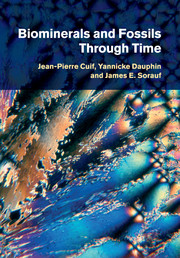Book contents
- Frontmatter
- Contents
- Preface
- Introduction: Milestones in the study of biominerals
- 1 The concept of microstructural sequence exemplified by mollusc shells and coral skeletons
- 2 Compositional data on mollusc shells and coral skeletons
- 3 Origin of microstructural diversity
- 4 Diversity of structural patterns and growth modes in skeletal Ca-carbonate of some plants and animals
- 5 Connecting the Layered Growth and Crystallization model to chemical and physiological approaches
- 6 Microcrystalline and amorphous biominerals in bones, teeth, and siliceous structures
- 7 Collecting better data from the fossil record through the critical analysis of fossilized biominerals
- 8 Results and perspectives
- List of references
- Name index
- Subject index
5 - Connecting the Layered Growth and Crystallization model to chemical and physiological approaches
Ongoing conceptual changes in biocalcification
Published online by Cambridge University Press: 10 January 2011
- Frontmatter
- Contents
- Preface
- Introduction: Milestones in the study of biominerals
- 1 The concept of microstructural sequence exemplified by mollusc shells and coral skeletons
- 2 Compositional data on mollusc shells and coral skeletons
- 3 Origin of microstructural diversity
- 4 Diversity of structural patterns and growth modes in skeletal Ca-carbonate of some plants and animals
- 5 Connecting the Layered Growth and Crystallization model to chemical and physiological approaches
- 6 Microcrystalline and amorphous biominerals in bones, teeth, and siliceous structures
- 7 Collecting better data from the fossil record through the critical analysis of fossilized biominerals
- 8 Results and perspectives
- List of references
- Name index
- Subject index
Summary
Research on the formation and properties of mineralized structures produced by living organisms is characterized by the diverse origins, methods, and aims of scientific investigators. This has resulted primarily from the rapid development of analytical methods in the second half of the twentieth century. As has been emphasized above in preceding chapters, the contrast between shell structures was never thought greater than at the beginning of this period. At that time, structures were still described with the optical microscope in the same way as Bowerbank had, yet, at the same time, were analyzed with the latest developments in theoretical and applied physics. These provided new data on isotopic fractionation in the calcium carbonate of the same shells.
Here we should emphasize that underestimating optical studies is a serious error. The logic of interpretations concerning the formation and method of growth of calcareous biominerals was influenced by their crystalline appearance in microstructural units, as observed with the polarizing microscope. It is important to acknowledge the great accuracy and precision of descriptions carried out at the end of the nineteenth and early twentieth centuries, and acknowledge our debt to these early researchers for the development of many of the major concepts in the field of biomineralization. Bourne (1899), in a seminal paper dealing with the formation of skeleton in the Anthozoa, carefully described the crucial zone of contact between the calicoblastic ectoderm and the corallite skeleton.
Information
- Type
- Chapter
- Information
- Biominerals and Fossils Through Time , pp. 277 - 314Publisher: Cambridge University PressPrint publication year: 2010
